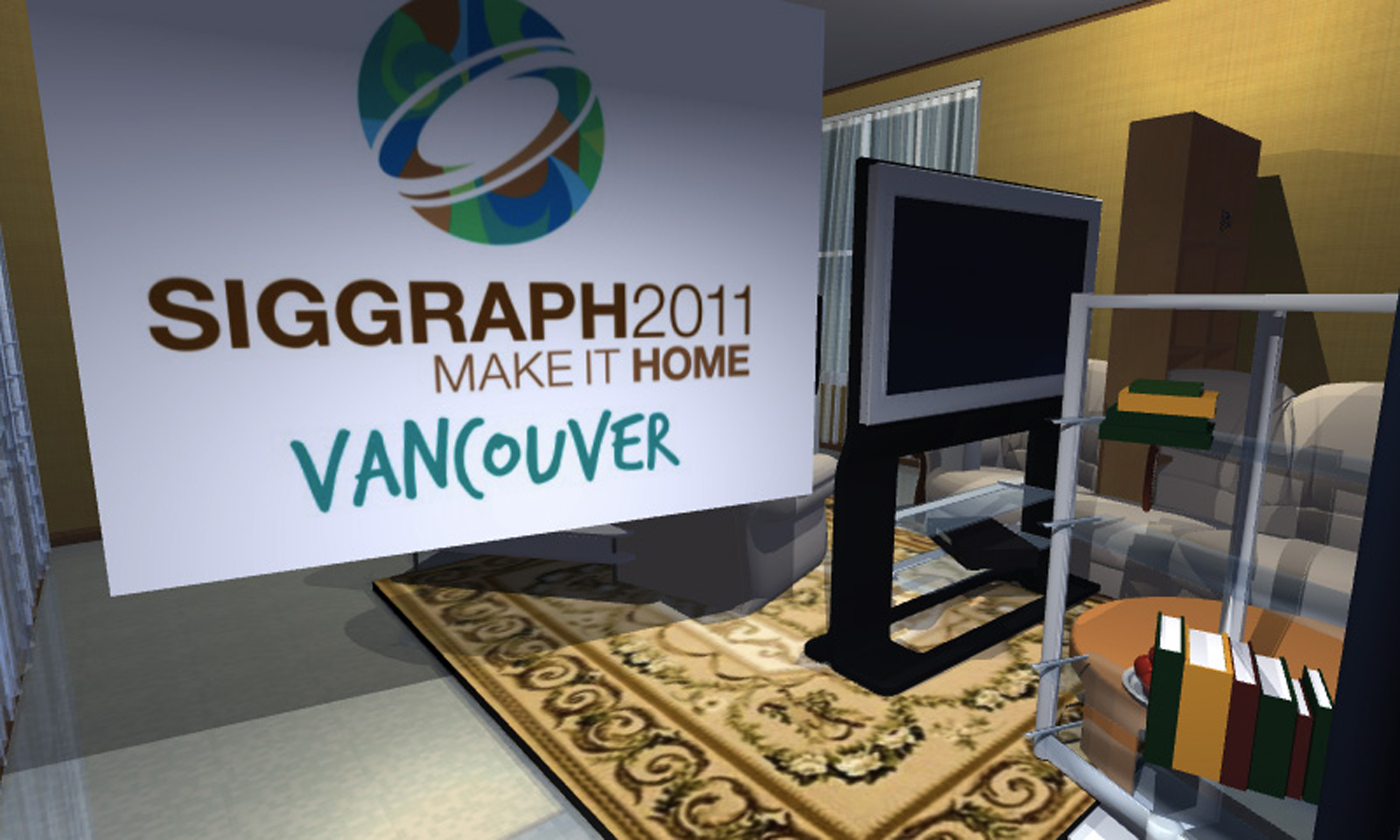“Make it home: automatic optimization of furniture arrangement” by Yu, Yeung, Tang, Terzopoulos, Chan, et al. …
Conference:
Type(s):
Title:
- Make it home: automatic optimization of furniture arrangement
Presenter(s)/Author(s):
Abstract:
We present a system that automatically synthesizes indoor scenes realistically populated by a variety of furniture objects. Given examples of sensibly furnished indoor scenes, our system extracts, in advance, hierarchical and spatial relationships for various furniture objects, encoding them into priors associated with ergonomic factors, such as visibility and accessibility, which are assembled into a cost function whose optimization yields realistic furniture arrangements. To deal with the prohibitively large search space, the cost function is optimized by simulated annealing using a Metropolis-Hastings state search step. We demonstrate that our system can synthesize multiple realistic furniture arrangements and, through a perceptual study, investigate whether there is a significant difference in the perceived functionality of the automatically synthesized results relative to furniture arrangements produced by human designers.
References:
1. Aarts, E., and Korst, J. 1989. Simulated Annealing and Boltzmann Machines: A Stochastic Approach to Combinatorial Optimization and Neural Computing. Wiley, New York, NY. Google Scholar
2. Akazawa, Y., Okada, Y., and Niijima, K. 2005. Automatic 3D scene generation based on contact constraints. In Proc. Conf. on Computer Graphics and Artificial Intelligence, 593–598.Google Scholar
3. Chen, G., Esch, G., Wonka, P., Müller, P., and Zhang, E. 2008. Interactive procedural street modeling. ACM Trans. Graph. 27, 3. Google ScholarDigital Library
4. Chib, S., and Greenberg, E. 1995. Understanding the Metropolis-Hastings algorithm. The American Statistician 49, 4, 327–335.Google Scholar
5. Ching, F. D., and Binggeli, C. 2005. Interior Design Illustrated, 2nd Ed. Wiley, New York, NY.Google Scholar
6. Chun, H. W., and Lai, E. M.-K. 1997. Intelligent critic system for architectural design. IEEE Trans. Knowl. Data Eng. 9, 625–639. Google ScholarDigital Library
7. Gallistel, C. R. 2009. The importance of proving the null. Psychological Review 116, 2, 439–453.Google ScholarCross Ref
8. Geman, S., and Geman, D. 1984. Stochastic Relaxation, Gibbs Distributions and the Bayesian Restoration of Images. IEEE Transactions on Pattern Analysis and Machine Intelligence 6, 6, 721–741.Google ScholarDigital Library
9. Germer, T., and Schwarz, M. 2009. Procedural arrangement of furniture for real-time walkthroughs. Computer Graphics Forum 28, 8, 2068–2078.Google ScholarCross Ref
10. Grunwald, P. 2007. The Minimum Description Length Principle. MIT Press. Google Scholar
11. Hastings, W. 1970. Monte Carlo samping methods using Markov chains and their applications. Biometrika, 97–109.Google Scholar
12. Jagnow, R., Dorsey, J., and Rushmeier, H. 2008. Evaluation of methods for approximating shapes used to synthesize 3D solid textures. ACM Trans. Appl. Percept. 4, 4, 1–27. Google ScholarDigital Library
13. Jimenez, J., Sundstedt, V., and Gutierrez, D. 2009. Screen-space perceptual rendering of human skin. ACM Trans. Appl. Percept. 6, 4, 1–15. Google ScholarDigital Library
14. Kirkpatrick, S. 1984. Optimization by Simulated Annealing: Quantitative Studies. Journal of Statistical Physics 34, 5, 975–986.Google ScholarCross Ref
15. Kjølaas, K. A. H. 2000. Automatic Furniture Population of Large Architectural Models. Master’s thesis, Massachusetts Institute of Technology, Department of Electrical Engineering and Computer Science, Cambridge, MA.Google Scholar
16. Larive, M., Roux, O. L., and Gaildrat, V. 2004. Using meta-heuristics for constraint-based 3D objects layout. In Proc. Conf. on Computer Graphics and Artificial Intelligence, 11–23.Google Scholar
17. Liu, J. S. 2008. Monte Carlo Strategies in Scientific Computing. Springer, New York NY. Google Scholar
18. Malnar, J. M., and Vodvarka, F. 1992. The Interior Dimension: A Theoretical Approach to Enclosed Space. Wiley, New York, NY.Google Scholar
19. Merrell, P., Schkufza, E., and Koltun, V. 2010. Computer-generated residential building layouts. ACM Trans. Graph. 29, 181:1–181:12. Google ScholarDigital Library
20. Metropolis, N., Rosenbluth, A. W., Rosenbluth, M. N., Teller, A. H., and Teller, E. 1953. Equation of state calculations by fast computing machines. Journal of Chemical Physics 21, 1087–1092.Google ScholarCross Ref
21. Mitton, M., and Nystuen, C. 2007. Residential Interior Design: A Guide to Planning Spaces. Wiley, New York, NY.Google Scholar
22. Müller, P., Wonka, P., Haegler, S., Ulmer, A., and Van Gool, L. 2006. Procedural modeling of buildings. ACM Trans. Graph. 25, 3, 614–623. Google ScholarDigital Library
23. Müller, P., Zeng, G., Wonka, P., and Van Gool, L. 2007. Image-based procedural modeling of facades. ACM Trans. Graph. 26, 3, 85. Google ScholarDigital Library
24. Panero, J., and Zelnick, M. 1979. Human Dimension and Interior Space: A Source Book of Design Reference Standards. Watson-Guptill, New York, NY.Google Scholar
25. Parish, Y. I. H., and Müller, P. 2001. Procedural modeling of cities. In Proc. Conf. on Computer Graphics and Interactive Techniques (SIGGRAPH ’01), ACM, New York, NY, 301–308. Google Scholar
26. Rouder, J. N., Speckman, P. L., Sun, D., Morey, R. D., and Iverson, G. 2009. Bayesian t-tests for accepting and rejecting the null hypothesis. Psychonomic Bulletin and Review 16, 225–237.Google ScholarCross Ref
27. Sanchez, S., Roux, O., Luga, H., and Gaildrat, V. 2003. Constraint-based 3D-object layout using a genetic algorithm. In Proc. Conf. on Computer Graphics and Artificial Intelligence.Google Scholar
28. Schneider, J. J., and Kirkpatrick, S. 2006. Stochastic Optimization (Scientific Computation). Springer-Verlag, Berlin. Google Scholar
29. Shao, W., and Terzopoulos, D. 2007. Autonomous pedestrians. Graphical Models 69, 5-6, 246–274. Google ScholarDigital Library
30. Talton, J. O., Gibson, D., Yang, L., Hanrahan, P., and Koltun, V. 2009. Exploratory modeling with collaborative design spaces. ACM Transactions on Graphics 28, 5, 167:1–167:10. Google ScholarDigital Library
31. Xiao, J., Fang, T., Tan, P., Zhao, P., Ofek, E., and Quan, L. 2008. Image-based façade modeling. ACM Trans. Graph. 27, 5, 1–10. Google ScholarDigital Library




